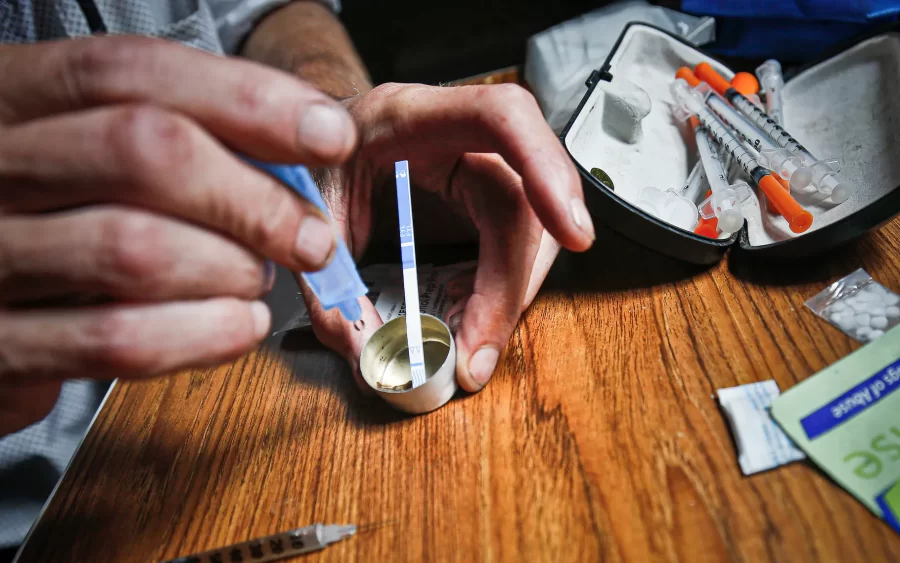OCS, Rural Response Network Dispense Naloxone, Fentanyl Testing Kits at Pop-up Event
On Thursday, March 23, the Rural Response Network and Oberlin Community Services hosted a harm reduction pop-up event at the Oberlin Public Library, dispensing naloxone — often referred to with the brand name Narcan — kits and fentanyl test strips.
Fentanyl test strips are available on a rolling basis at Ginko Gallery, the Oberlin Public Library, Christ Episcopal Church during its hot meals program, and the Sexual Information Center on Oberlin’s campus. Narcan kits cannot be offered on a rolling basis because they require training. Most people receive narcan training at pop-up events.
Outside of pop-ups, RRN’s Oberlin Community Coordinator Marla Brewer, who works to organize events and set up resource distribution sites, has Narcan kits available at Oberlin Community Services.
“I want it to be accessible without question, so that people don’t have to feel shame in asking,” Brewer said. “I’ve noticed that when I do a pop-up on campus, they are running for it, but no one comes [to Oberlin Community Services] and asks me for it. Having to initiate it just stops them.”
In 2021, the National Institute on Drug Abuse recorded 106,699 overdose deaths, an increase from 91,799 reported deaths, or approximately 28.3 overdose deaths per 100,000 people in 2020. Since 2016, fentanyl has been the leading drug involved in overdose cases nationally and locally in Lorain County. In 2015, the Lorain County Health Department reported 21 deaths due to fentanyl overdose. In 2020, the county reported 117 fentanyl deaths.
The resource distribution efforts are an initiative of the Rural Response Network, which is funded by a grant of $1 million that the LCADA Way received in September 2022 from the Health Resources and Services Administration. RRN is a partnership between nine community and government organizations which work to provide support and education for residents of Oberlin, Wellington, and the surrounding townships, with the goal of reducing overdoses and overdose deaths.
One of Brewer’s current initiatives is providing lockable medication bags at Oberlin’s CVS, which can prevent prescription medication from being accessed by individuals to whom the medication was not prescribed.
“Prescription meds are one part of the problem, but it’s really not the prescription, it’s the counterfeit pills given on the street, especially targeting college-age individuals, but it could be anyone at any age,” Brewer said.
Counterfeit pills can look identical to prescription medication, so Brewer recommends individuals use fentanyl test strips for any substances they ingest that are not received from a pharmacy. Fentanyl test strips can detect fentanyl in drug residue mixed with water.
Fentanyl test strips use a single line to indicate a positive test and two lines indicate a negative test. The test strips were decriminalized in Ohio during January of 2023, allowing organizations to give them out.
Naloxone reverses the effects of opioids on the body during an overdose. During an opioid overdose, the central nervous system is dampened and the brain is starved of oxygen. Brain injury can occur after three to six minutes of oxygen deprivation and death can occur after 10 minutes. In rural areas of the United States, the average time for an ambulance to arrive is 14.5 minutes. Naloxone can reverse the opioid’s effects faster than health-care providers may be able to respond.
Brewer recommends that individuals carry naloxone, regardless of whether they are a drug user or know someone who is.
“It’s an issue for all of society,” Brewer said. “Even if we ourselves are not addicts or surrounded by addicts, it’s something that we need to understand is happening all around us and we need to be aware. Carrying and using Narcan is one simple way to reduce harm and potentially save a life.”
The Substance Abuse and Mental Health Services Administration advises bystanders to call 911 immediately if a person exhibits any of the symptoms of an overdose. After calling 911, bystanders can administer naloxone.
The symptoms of an overdose include a pale or clammy face, body going limp, fingernails or lips turning blue or purple, vomiting or gurgling, unconsciousness or inability to speak, and a slowed heartbeat or breathing. After calling 911, bystanders can administer naloxone and facilitate breathing with “rescue breaths.”
Seven people were trained to use Narcan at the pop-up. In addition to naloxone, the kits provided by Brewer include a face shield, which allows the user to perform rescue breaths and CPR without having direct mouth-tomouth contact with the patient.
“We don’t currently have another pop-up planned, but I would love to see that happen,” Rebecca Wedge, adult services team leader at the Oberlin Public Library, wrote in an email to the Review.
Brewer emphasized that, in other villages and townships across Lorain, there is an even greater need for the services she works to provide at Oberlin.
“Oberlin and Wellington aren’t even the hardest hit,” Brewer said. “LaGrange, Grafton, the even tinier communities that don’t have anything — they don’t have any community center, they don’t have any resources — it’s a problem.”





